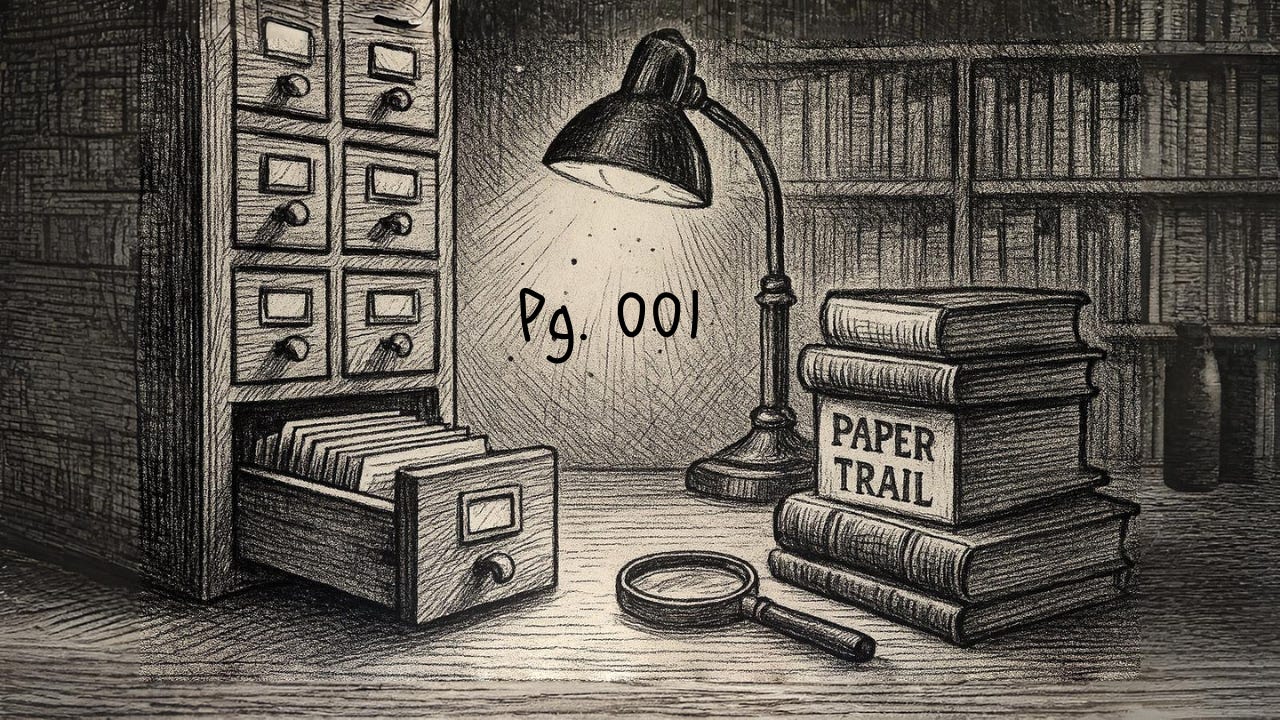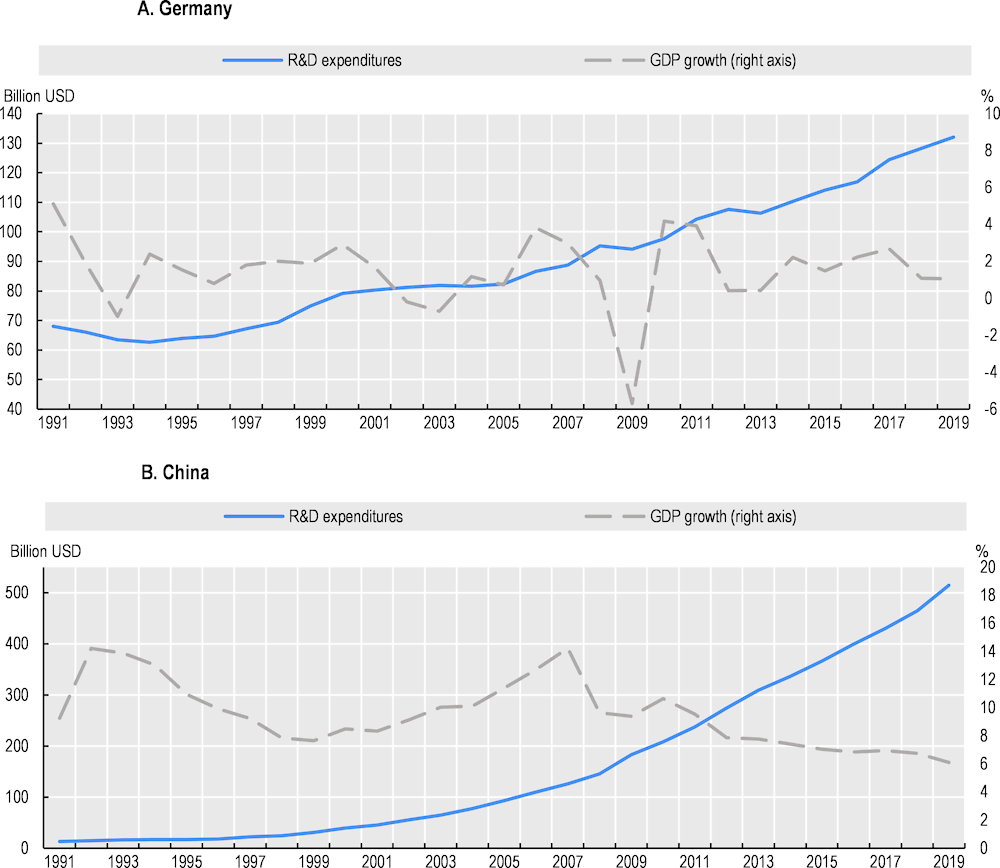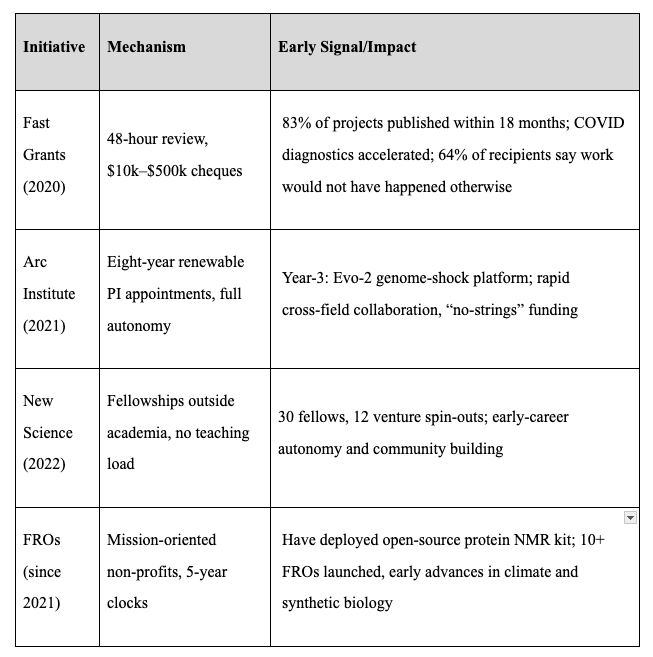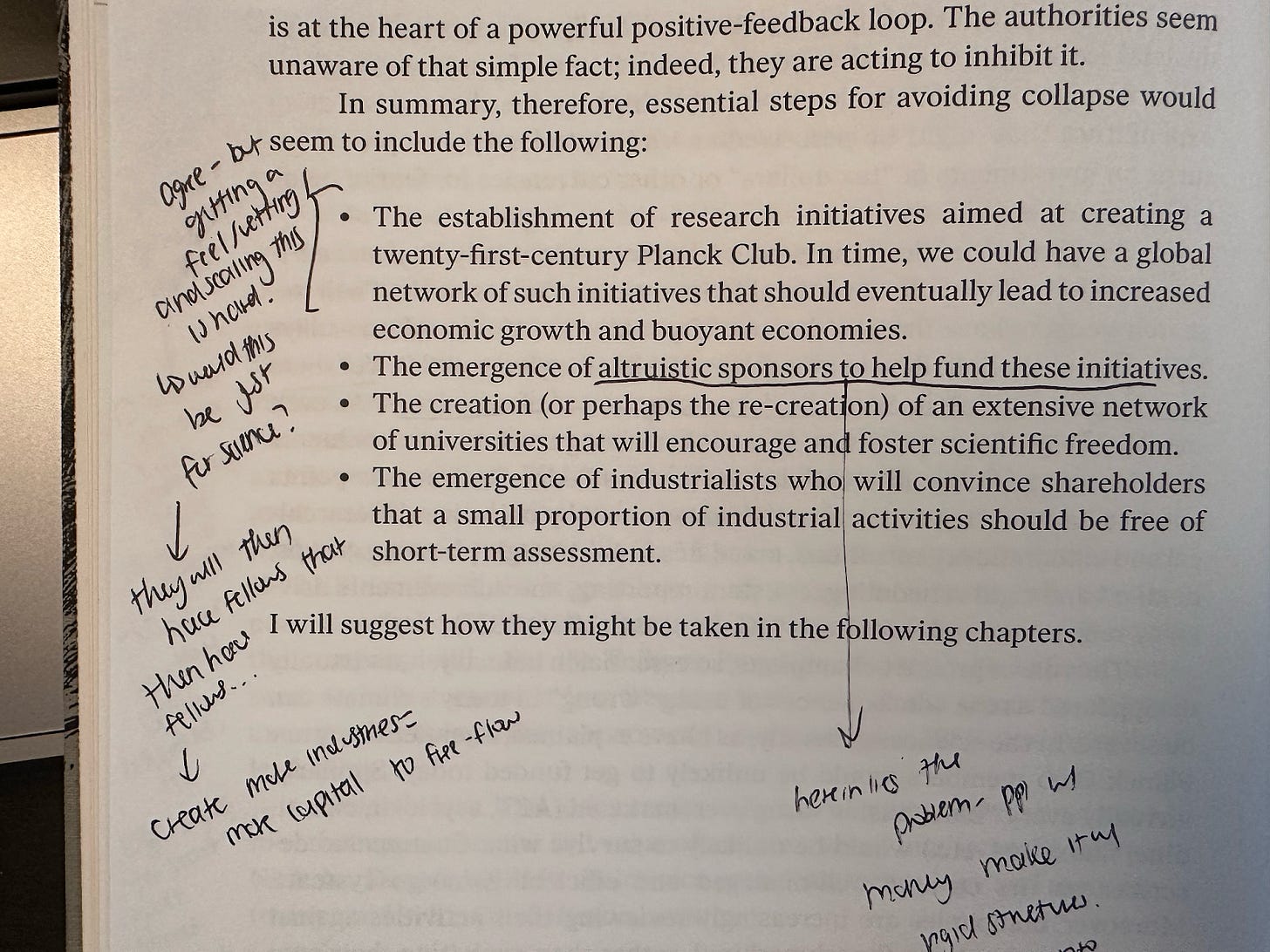
I inhaled Donald Braben’s Scientific Freedom: The Elixir of Civilization in a single weekend, right as the 2025 NIH cuts yanked $20 billion from biomedical research overnight. Talk about timing.
The Architecture of Scientific Decline
Across just one decade (1980-1990), Donald Braben’s BP Venture Research Unit backed forty radically un-reviewed projects with £20 million and still chalked up fourteen “breakthroughs” – quasicrystals, blue LEDs, chaotic fluid mixing, squeezed states of light — an incredible feat essentially unmatched by any other organization…
…but an act of the past. Braben argues that modern R&D began to stall after the 1970s, with the expansion of accessible higher education and the simultaneous rise of risk-averse peer-review committees. The result, he says, is an “architecture of decline” that channels talent into incremental work instead of frontier exploration. His theory rests on three structural pillars:
The Democratization Paradox – opening university doors (there was a staggering 147% increase in university enrollment from 1970 to 2008) created a far larger pool of potential breakthrough scientists, yet intensified competition pushed gatekeepers to favour projects whose outcomes can be forecast ex-ante, stifling novelty.
Peer-Review Pathology – committee scoring systems reward consensus; proposals that look “unrecognizable” to today’s experts are systematically filtered out. Meta-studies of journal and grant review confirm that peer review both misses rigor problems and penalizes originality.
The “Shadows of the Future” – because careers now hinge on continuous external funding, researchers self-censor ambitious ideas long before a panel sees them, opting instead for projects that look safely fundable
BP’s Venture Research served as a natural experiment: remove those three constraints, and the hit rate for transformative science jumps an order of magnitude. Freedom, not money, is the scarce input. Once curiosity has room to roam, modest budgets suffice.
The Cracks in the Glass
The Emergence of Competitive Gatekeeping
Before 1970, tenured academics typically had access to modest resources they could use as they pleased without external oversight. However, the massive expansion of universities created what Braben calls a “ballooning, mushrooming, unsustainable number of researchers.” While expanding the educated population was net positive, this explosion in academic personnel necessitated new systems for allocating increasingly scarce resources per capita, despite absolute increases in funding.
The supposed solution was the formalization of peer review for research funding, which Braben argues has become “disastrous” for scientific progress. Success rates for research grants now hover around 20%, meaning that many excellent proposals are lost, but even those that succeed are not actually prone to success. In essence, peer reviewers are more likely to fund research they can understand and predict.
The Institutional Paradox
Universities themselves became complicit in this transformation. The current system relies on “a disproportionate and growing cross-subsidy from universities to make research viable.” The “stop-start” nature of government funding creates abrupt breaks in projects, preventing the development of critical mass in infrastructure and expertise while disincentivizing interdisciplinary collaboration.
This institutional pressure manifests in what researchers call the “pre-research” problem, where scientists are encouraged to build extensive networks and anticipate every potential problem before the chance to even begin their work. Rather than allowing researchers to start foundational new investigations, the system forces them to build incrementally on established foundations, clinging to known and “safe” approaches because of the high costs and failure rates associated with truly novel research.

We went from a world where perhaps only 500 people could make transformative discoveries to one where tens of thousands could, but shot ourselves in the foot by building selection mechanisms that filter for conformity instead of genius.
Do the Locks Still Hold? 2008 vs. 2025
When Scientific Freedom first appeared in 2008, many critics dismissed its warnings as a form of nostalgia. Yet a cascade of twenty‑first‑century data suggests Braben was, and still may be, directionally correct:
The Productivity Slide — Bloom et al. (2020) show research output per dollar falling roughly 5 % per year despite rising headcount. The more talent we pour in, the flatter the discovery curve becomes. This decline is not confined to America; follow-up studies applying the same methodology found similar patterns in Germany (5.2% annual decline) and China (23.8% annual decline).

R&D investment and annual GDP growth rates in Germany and China, 1991-2019. Research efforts must be doubled every 13 years in Germany and every three years in China just to maintain constant economic growth rates. Source: OECD
Imagine making a chef write an application to use their stovetop. That’s what we’ve done to researchers, who spend 40% of their non-teaching time writing grants.
NIH 2025 Shock — A sudden 43 % contraction in U.S. biomedical funding exposed how brittle the incremental grant treadmill is. Entire labs evaporated within a funding cycle. The Trump administration's proposed 43% reduction in NIH discretionary funding to $27.5 billion for 2026—an $18 billion cut—has provided a real-time demonstration of the fragility Braben warned about. The proposed changes would reduce grant applicants’ odds of securing new awards to historic lows while simultaneously cutting support for researcher training by $359 million. This creates precisely the kind of abrupt breaks in projects that Braben argued prevent the development of critical mass in infrastructure and expertise.
The Peer Review Bottleneck Intensifies – A 2024 analysis found that peer review processes now take 11 months for initial reviews, with editors reaching out to 60 reviewers to secure just two reviews. The system's inability to handle volume while maintaining quality validates Braben's argument that peer review creates barriers for newcomers and systematically holds back diverse ideas.
Hype Cycles and the Illusion of Progress - The digital age has magnified exactly the failures Braben foresaw. arXiv uploads keep climbing exponentially, yet the flood of manuscripts has not yielded a matching surge of transformative discoveries. Log onto Twitter, and you’ll see a convergence of similar projects, messaging, and cults of personality. Hype spills into bench science itself: A 2024 survey of 1,600 biomedical researchers found that 72 % see a reproducibility crisis and 62 % blame the “publish-or-perish” treadmill.
Corporate laboratories show the same drift. As Braben warned, “the great companies … have virtually ended their support for exploratory research.” Most industrial R & D money now chases fashionable bets—autonomous vehicles, generative AI, quantum hardware—while programmes for “dreamers, heretics, mavericks, gadflies, and geniuses” disappear. IBM’s Fellows scheme appointed just 165 scientists (at the time of Braben’s writing, 2008) yet produced five Nobel laureates; few equally unconstrained platforms exist in 2025.
Crowd-Funded Microproof — Data from Experiment.com indicates that 64% of funded projects would not have proceeded under conventional grant mechanisms. In addition, students and junior investigators are more successful than senior scientists at securing alternative funding - it isn’t the quality of ideas, but credentialism, where peer review “creates barriers for newcomers to enter…you can only get in by getting them to like you over and over, which is doing what’s replicable.” This is also because “you [the student] are signed up to lose your most creative years. You are not the face of your research, but someone else’s research. Those who have a face are very rare.”

Now, the Contemporary Challenges
While Braben’s core claims endure, four changes complicate direct transplantation of his model:
The Selection Paradox - Picking Plancks in a Crowded Field
Explosion of Talent Pools: The democratization of higher education has produced an order-of-magnitude increase in the number of potential breakthrough scientists. The pool is vastly more diverse than in the Planck/Feynman era, with more women, minorities, and international students gaining access to advanced training. The days when 96% of Nobel chemistry laureates could be traced to a single academic “family tree” are over.
Triaging the Exceptional: With tens of thousands of highly credentialed applicants, finding the next Katalin Karikó is a needle-in-a-haystack problem. Traditional peer review and “old boys’ club” heuristics are simply overwhelmed by the scale and diversity of the modern applicant pool.
Specialization and Evaluation Bottlenecks: As research fields fragment into ever-narrower specializations, the number of true peers capable of evaluating cutting-edge proposals shrinks, making it harder to recognize outlier talent or interdisciplinary promise.
Noisy Hype
Platforms like X, Kickstarter, and Experiment.com have shown that unconventional projects can succeed in receiving funding outside of conventional sources, but success on these platforms often correlates with storytelling skill, social reach, and emotional appeal, not necessarily scientific merit. The digital age allows incremental results to go viral, while slow-burn research is easily drowned out.
This rewards attention-grabbing narratives over substance, but also disadvantages certain fields over others (think: projects in biochemistry vs. computer science. One is inherently slower than the other). There are hundreds of downstream effects, but a primary result is a loop of copycat “flashy” projects: Twitter PR and VC FOMO reward legibility over depth. Future selection systems must filter for true originality and leave headroom for brilliance from outside the usual power centers.
The increase in accessible technology and falling costs of experimentation (see: AI and biotech) mean more people can try transformative work, but also that the volume of mediocre or derivative projects rises even faster.
Global equity and access: selection mechanisms must leave room for brilliance from outside the traditional centers of science (read: America). Capturing talent globally is a growing priority.
Leadership Drought: The Vanishing of Integrators and Adventurers
Rise of the Middle Manager: The current system mints excellent L6 engineers but few Vannevar Bush–grade integrators or scientific adventurers. The culture of “break things fast” and performative productivity discourages the kind of patient, deep, cross-domain thinking that produced historical scientific leaders. How many 20-year-olds would sit and contend about the natural world the way that Sir Isaac Newton supposedly did? (This is a half-joke, in that the apple story is a myth.)
Delayed Independence, Stunted Creativity: The age at which young scientists can pursue independent research has risen, and the path is more bureaucratic and less adventurous than in previous generations. Many spend their most creative years as “postdocs for hire,” with little room for risk-taking or leadership development.
Leadership Crucibles Needed: There is a growing call for “leadership crucibles” — rotations through policy, industry, and basic labs — to forge the cross-domain fluency and resilience needed for future scientific leaders. The current system’s focus on replicable, technical skills does not foster the original, integrative thinking required for major breakthroughs.
Cultural Aspiration Gap: The Lost Prestige of the Scientist-Adventurer
Diminished Idolization: Unlike the mid-20th century, when Einstein and Feynman were household names, today’s scientists rarely achieve celebrity status outside niche circles. The public narrative now exalts startup founders and tech billionaires, not discoverers or explorers.
Pipeline Risk: This shift in aspiration is not trivial. It means fewer young people are drawn to research careers, and some fields risk extinction as talent flows to more glamorous or lucrative sectors. Even among the “best scientists under 40,” few are widely known or celebrated.
“There isn’t a large group of young people who are vying to be scientists, at least, not to the same extent as a few generations ago. This is important because it does mean that we’re going to have a dwindling number of people who become ‘researchers’ and there are some fields/intersections that could seriously go extinct.”
The Patience Deficit
Patient Capital Is Scarce: Visionary “patient capital” — the kind that backed Oxford Nanopore for nearly two decades — is rare, and most VC funds simply do not have the time or mandate to wait for long-term payoffs. As a result, high-risk, high-reward research is systematically underfunded, and even promising projects are pressured to pivot to quick-win applications or exit strategies.
Funders Want Quick Exits, Not Decades of Deep Science: The venture capital model has shifted dramatically toward seeking faster returns, especially with the boom of Silicon Valley and software-oriented investments. This is fundamentally misaligned with the timelines required for deep, high-impact science, where breakthroughs like gene therapy or new materials may take a decade or more to reach fruition.
Researchers and Founders Expect Speed: On the builder side, the culture of “move fast and break things” has permeated even deep tech and science. The expectation is for rapid, visible progress is antithetical to the slow, iterative, and often failure-ridden process of genuine discovery.
Impatience Undermines Risk-Taking: Builders are incentivized to chase what is fundable now, rather than what could be transformative in a decade. The result is a focus on incremental, “safe” projects that can show results quickly, further reinforcing the cycle of short-termism.
The “Lifestyle Creep” of Science: As AI and digital tools make some aspects of science faster, expectations for speed rise across the board. The public, policymakers, and even scientists themselves become less tolerant of the long, nonlinear timelines that real breakthroughs require.

Translation: most transformative research is cheaper than you might imagine. The expensive part is giving people 5-10 years of protected time to think. As Donald Braben puts it:
“Very expensive equipment was usually unnecessary because the scientists were going into virgin terrain, which from a scientist's point of view is the ultimate target-rich environment.”
Mobilized Responses
The 2010s-2020s have not been idle. Several programs (some examples below) are already operationalizing pieces of Braben’s vision, and have adapted to a few of the contemporary challenges listed:

How to (Actually) Build This
Each model only partially addresses the deeper structural traps Braben identified. To truly escape the “coordination games,” we need to go further.
I’ll caveat that cross-comparing different types of scientific funding is complex to standardize - science is “dominated by outlier discoveries, not typical discoveries,” funding it, therefore, is also riddled with exceptions, not norms.
With this in mind, I outline a set of design principles and mechanisms—rooted in both historical precedent and recent research—that could close the remaining gaps. The dual-track approach I've been thinking about works like this:
Dual‑Track Funnel — Stage 1: micro‑grants (US$10k, one‑week decision) to surface eclectic ideas. No peer review, just sanity checks and good faith that the individual/group will follow through (often a gut feeling). Stage 2: deep‑freedom grants (US$500k × 5 yrs) when projects feel ready to scale up, and have shown early promise - not based on a consensus forecast.

“We never had to consult each other about whether or not a person was a venture researcher... It was so obvious that this person was on the threshold of doing something very important.”
Parallel Planck Clubs — Discipline‑specific groups — neurotech, materials science, creative tech — run in parallel with no forced ranking between fields. Just because one takes longer than the other does not mean it is inferior. Let long-term results determine payoffs.
Slow‑Thinking Sabbaticals — Protected intellectual solitude; thinking time often beats lab time on virgin terrain. Budget at least six months per five‑year cycle exclusively for reflection. This time is free from deliverables and reporting. It is introspective rather than for relentless output. Radical candour and honesty with the individual/team/continuation of the project is best done here.
Scrappy Teams — Cap headcount at six. The goal is intellectual velocity, not managerial scalability. Prioritize small, high-trust groups (both in teams that provide support and those that are conducting research) to maximize intellectual velocity and flexibility.
Narrative Reporting — Annual letters modelled on Buffett’s shareholder missives replace KPI dashboards. Final evaluation occurs only after year five, allowing for an honest contextualization of setbacks, pivots, and serendipity.
Who Could Make it Real?
The candidates below are chosen because they already possess at least one “anti‑blocker” asset: patient capital, protected governance lanes, or cultural prestige that can absorb early ambiguity. While specific names are listed, each proposal could be adopted to an adjacent organization with a similar structure/assets.

Each proposal will inevitably collide with two classes of blockers: (i) Institutional inertia (quarterly earnings, academic prestige games, procurement red tape) and (ii) Attention wars – it is neither glamorous nor immediately publishable to sit in a five‑year quiet period.
Implementation Hurdles & Mitigations
Governance Freeze: Legal departments will resist open‑ended budgets.
Optics Risk: ARPA‑H must justify non‑milestone grants to Congress; other bodies need to justify to their LPs or funders.
Talent and Recognition: Researchers wary of career limbo may hesitate to participate, or may seek more public recognition or support.
Public ↔ Expert Mismatch: Crowdfunded hype might skew toward flashy topics, and struggle to value scientific depth or foundational-skewing research, even with an esoteric “Planck jury.”
Open Questions
Things I’m still wondering about:
Crowd ↔ Jury Hand-off – Where should public enthusiasm end and expert discretion begin so we capture both breadth and depth without descending into popularity contests? How do we ensure that these ‘juries’ minimize repeated flaws of peer review?
Global Scouting – How do we surface brilliance outside the Anglosphere’s algorithmic noise - would this involve greater numbers of regional scouts and language hubs?
Selection Machinery – With exponentially more potential Plancks and fewer true cross-disciplinary reviewers (also attributed to the specificity of knowledge some new projects demand), what triage system can spot genuine step-changes without defaulting to pedigree or citation counts? How do we step aside from false positives?
Patience Economics – Which financial structures can underwrite beyond five-year latency and narrative-based evaluation? How can we instill a sense of patience and humility among young researchers and funders in a digital, generative environment?
More Apples on the Head, Darn It – What twenty-first-century educational, cultural, or societal interventions can cultivate the next Vannevar Bush or Max Perutz, rather than another cohort of mid-managers?
–
Hat-tips to my friend, James Hill-Khurana, for an excellent interview with Don Braben himself that sparked my first interest in this book, and notes from Jacky Zhao for sobering second thoughts.









This is superb. A worthy roadmap of what is starting to feel like a movement in its infancy, as I look around me and listen to others.
Regarding your Open Question #2, I'm thrilled to read someone thinking about it, but —and it's surely my own personal bias—I'm finding the framing (respectfully) narrow. If science is being torn down in the West and we're playing for all the marbles, I feel we can be far more creative and ambitious than simply imagining a new scientific hegemon with scouts concentrating the best and brightest from regional nodes towards a central node. We have the technology to reinvent the idea of scientific hegemony itself, and even though realistically it might never happen, this is the time to dream alternate futures. Science operates across many registers and with different objectives across different contexts—multiple overlapping but distinct networks, maybe; I think you were gesturing towards that with "language hubs". We have a lot to learn from each others' networks in this way!